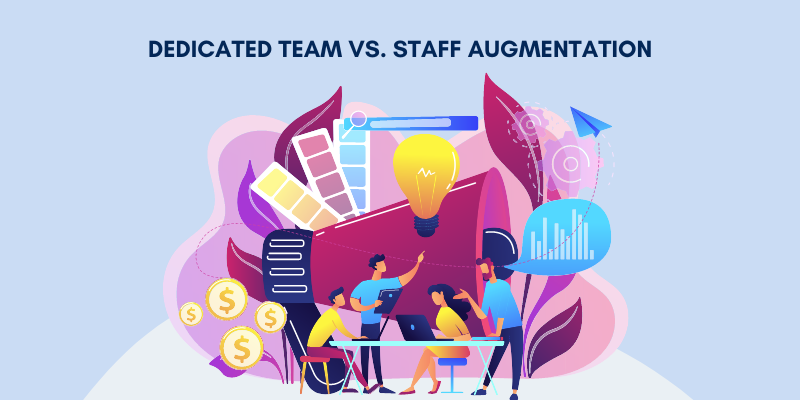Dedicated Team vs. Staff Augmentation

In a business world that is uncertain and constantly changing, there is a growing need for specialized IT services. But the market has to deal with the fact that there aren’t enough skilled software developers. The good news is that IT outsourcing has saved the day. With its many benefits, like reducing project time and costs, using the knowledge of a skilled IT partner, and improving operational efficiency, you can focus on your core business. Because of this, more and more companies are giving IT jobs to outside companies. Regarding IT outsourcing, it’s hard for many companies to decide between staff augmentation and a dedicated team.
There are different ways to work together with a software vendor. Staff augmentation and outsourcing a dedicated team of professionals are two of the most common.
But how should you decide?
First, let’s talk briefly about what each model is.
What does Staff Augmentation mean?
Staff augmentation is an outsourcing model in which a software development company offers employees to fill in any gaps in your team’s technical knowledge. Outsourced developers are part of your engineering team but work from home. Team expansion is another name for staff augmentation.
Most IT staff augmentation is done on a “time and materials” basis, which means that the cost of staffing depends on the size and scope of the project and the amount of work that needs to be done. A fixed-price business model might also need a fixed budget and a well-defined project scope.
Remember that you still need to engage and attract new tech talent to your internal team even if you hire more people outside your company. Groups that work hard don’t have this problem.
What are the disadvantages of IT Staff Augmentation?
Not great for ongoing projects: IT staff augmentation isn’t the best way to find the talent you need on an ongoing basis or for long-term projects. Before the project ends, workers may have to move on to other projects or leave the supplier’s company for a more permanent position. Also, staffing increases are often billed based on time and materials, which means you could end up paying for things you didn’t need.
Not suitable for institutional knowledge-based projects: When a project needs a deeper understanding of how the client’s business works, hiring more people often means a long period of growth.
Risk of becoming dependent: When employees use a third-party vendor more, they may become more reliant on that vendor. For example, there is no guarantee that a supplier can give you the talent you need if you are hiring more people so you can use the same skills on multiple projects. If you need a specific skill all the time, you should hire people with that skill or sign a long-term contract with the service provider you use.
Inconsistent quality: The way employee enhancement works means a lot of turnovers since people often work on short-term contracts or as freelancers. So, the same people may be unable to work on projects when needed. Because of this, customers have to work with different suppliers and employees, which can cause quality to vary.
When is use IT Staff augmentation?
Any collaboration model will work better for some businesses than others, depending on many key factors. Staff Augmentation is a great idea for a business with a strong IT team and a management team that people trust. On the other hand, if the internal team is too busy with other tasks and the project needs to be finished quickly without internal management, it is highly recommended to consider other options, such as outsourcing.
Adding people to your software team will help your business if:
You want to hire a small number of programmers from other places because it’s hard to find them in your area;
You want to hire some professionals from somewhere else because there aren’t enough good ones in your area;
You expect to manage and talk to new people on your team every day or every week;
You want to add an expert who works remotely to your team.
What is a Dedicated Team?
A dedicated team is an IT outsourcing model in which a company gives you a software development team that works from afar and is wholly focused on your product and business goals. Outsourced developers are chosen by hand based on what you need and can be managed by you.
One problem with outsourcing that is easy to see is the lack of individual leadership and a sense of unity.
With other IT outsourcing models, you still get a great product at a great price, but you can’t lead the team that makes your vision come to life. You don’t have much to say about who should work on the project and how it should be run. This problem won’t happen if you have a dedicated team because you’ll be able to be the leader of your team and help hire people.
A dedicated team brings a sense of unity, which is especially important for startups and new products where creativity is a key factor in their success.
So, the only thing that reminds you that your team isn’t in your office is that team members aren’t there. But with modern tools for keeping track of and talking about work, this “remoteness” is hardly noticeable. Even more so now, half of the world’s population works from home, and some companies are switching to remote work because of the pandemic and the huge paradigm shift it has caused.
Some of your dedicated team may also visit you in your home country, which is also common. So, you can strengthen partnerships, improve communication, and build stronger, longer-lasting relationships with your team.
What are the benefits of hiring a dedicated team?
Customers frequently use this outsourcing approach when they need to upskill to take on new projects or meet rising demand but lack the resources to find, hire, and train qualified workers.
Here are some good things about using this method:
Enable internal and external teams to work together. When you work with a nearshore company, it’s easy for dedicated development teams to work with your employees and as a single, distributed team.
More controls: Because this model encourages customers to be involved in a lot of ways, organizations can keep a better handle on processes, processes, and quality standards.
The costs are predictable: When compared to hiring people, working with dedicated development teams gives companies a better idea of how much it will cost. Customers pay the same flat rate every month, which gives them more control over how much money they spend.
Scale up or down as needed: Customers can easily add or remove team members to scale up or down as needed. Multiple contracts let customers temporarily add more developers to their plans to meet short-term spikes in demand or get a specific skill for a project without the cost or risk of breaking labor laws that come with doing this from home.
What are some limitations?
There are many good reasons to work with a team of dedicated software developers. But this model requires a lot of planning, teamwork, and a clear picture of how your outsourced team will help you reach specific goals.
Since this strategy requires customers to spend time and money to add external developers to existing teams, it is not always the best option for organizations that are short on time or money.
Here are some of the problems with this choice:
Not suitable for short-term goals or projects. When you want to add permanent or permanent capacity, you often contract to work with a dedicated team. Because of this, external teams tend to keep a steady pace and aren’t ready to meet short-term needs. Dedicated groups in this way are much like what happens when your team is too spread out.
It might cost more than other ways of pricing. Maintaining a follow-up workgroup can be more expensive than choosing time and materials or fixed-price contracts for short-term projects because you’ll need to outsource a certain amount of work to get the most for your money.
Taking care of dedicated teams is a big job. Even though the supplier is in charge of hiring people, figuring out rates, and matching customers with the right people, companies that use this model should be ready to spend a lot of time managing external teams.
It is worth mentioning that many Tiempo employees stressed the need to integrate foreign staff into the corporate culture in an internal poll. For customers, this involves maintaining open lines of communication, setting clear expectations, and participating in team-building exercises.
When should a Dedicated team be used?
Startups do well with dedicated developers and teams, which lets you find programmers quickly without spending much money on hiring. Also, if your product is still in the “discovery” phase, this collaboration takes time and keeps you from spending too much.
So, the internal team can focus on the most important tasks, and your dedicated team can quickly add new tasks and processes.
Long-term or complex projects. Dedicated teams are a reliable and cost-effective alternative to staffing if you need help on an ongoing basis. This model will help projects that need to understand the business and its goals in context and those that need to test, update, and keep getting better.
Dedicated teams accumulate knowledge and learn about the organization over time. On the other hand, using temporary labor requires the customer to constantly hire and teach new engineers to catch up to where the team eventually stopped.
The internal team lacks the knowledge and resources required to meet business requirements. When an in-house team lacks the time or abilities to take on additional tasks, or when the customer has the means to acquire new staff, dedicated teams present an appealing alternative. When dealing with a nearshore provider, specialized development teams will provide the same experience as an inbound delivery team but at a considerably cheaper cost.
Projects in which scope changes or requirements are unclear. If you have a dedicated nearshore team, this strategy works well for projects that require teams to react to changing requirements or when specifications are not stated. Internal and external teams can implement Agile best practices and come to market faster with the correct strategy and tools.
What to Choose: Staff Augmentation or Dedicated Team?
Even though the dedicated team and staff augmentation are related, you can’t switch between these two IT outsourcing models.
A dedicated software development team is the best choice if your company has no technical skills or needs a team for a new project. The same is true for smaller parts of bigger projects. When these things happen, the increase in staff won’t be stopped.
On the other hand, staff augmentation is a great way to quickly add the people who are missing from a project that is already going on. When the size of your project changes or people leave, you may need to find new software developers quickly. It can be hard to find the right person with the right experience. Companies that make software probably already have experts or a good recruitment department and process, so they can quickly find the talent they need. In this case, having a dedicated team is too much.
Simply put, there are many ways to share your ideas in IT outsourcing. If none of the above partnership models work for you, you can talk to a reputable outsourcing software development company like Lextricon about your needs and other options. Feel free to contact us if you need a dedicated team, IT staff augmentation, or other software development services. We have years of experience building digital products and technology teams for international companies, so we can find the right people to make your vision come true.


